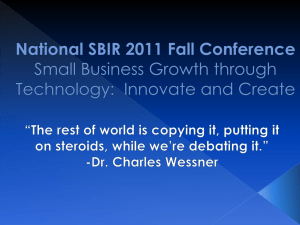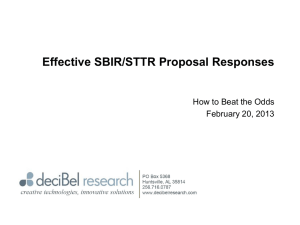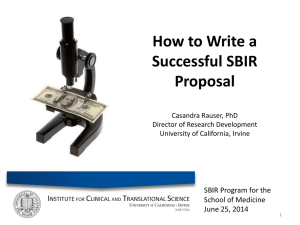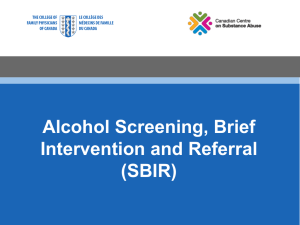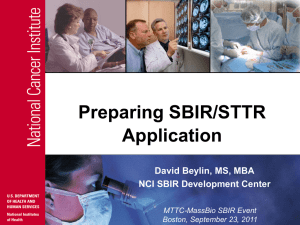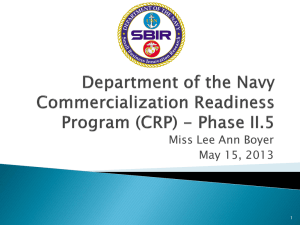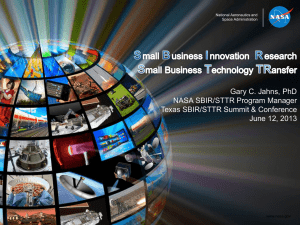SBIR/STTR Overview - Nevada Small Business Development Center
advertisement
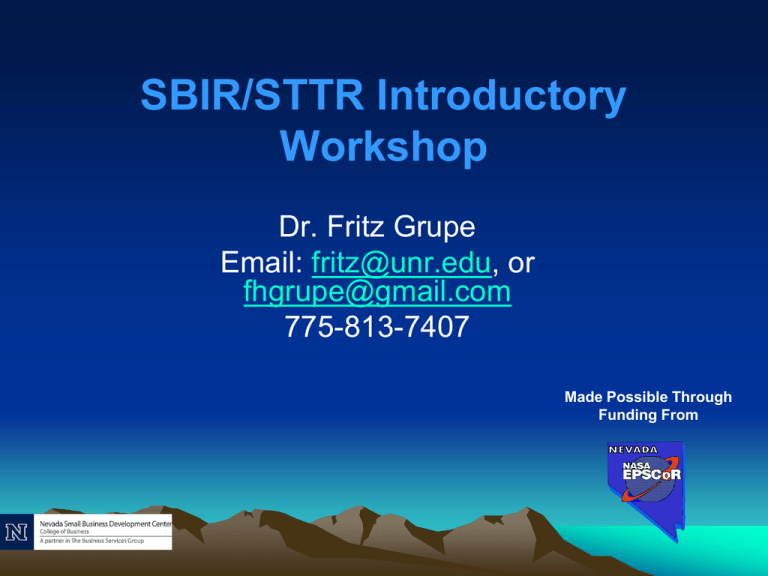
SBIR/STTR Introductory Workshop Dr. Fritz Grupe Email: fritz@unr.edu, or fhgrupe@gmail.com 775-813-7407 Made Possible Through Funding From Workshop Agenda • • • • • • • • • What are SBIR and STTR? The phases Eligibility Agency differences What do they pay for? University participation Resources you can draw on Summary of characteristics of successful proposals Summary of why you might consider applying Show Me The Money!!! Why SBIR???? Small Business Innovation Development Act of 1982 Congress designated 4 major goals • Stimulate technological innovation • Use small business to meet federal R&D needs • Increase private-sector commercialization innovations derived from federal R&D Research Opportunities Reserved for Small Business • Small Business Innovation Research (SBIR) 2.5% Set-aside for small businesses to engage in federal R&D -- with potential for commercialization. (will be increasing to 3.2% over 6 yrs.) • Small Business Technology Transfer (STTR) Set-aside to facilitate R&D between small 0.30% business concerns and U.S. research institutions (increasing to .45% over 5 yrs.) SBIR Program Eligibility • Organized for- profit U.S. business • At least 51% U.S.- owned and independently operated OR at least 51% U.S.-owned and controlled by another for-profit business that is at least 51% U.S. owned and independently operated • Small business located in the U.S. • 500 or fewer employees • P.I.’s primary employment with small business during project STTR Program Eligibility • Applicant is a small business – Formal cooperative R&D effort • Minimum 40% by small business - Minimum 30% by U.S. research institution • U.S. research institution – College or university; other non-profit research organization; Federal R&D center • Intellectual property agreement – Allocation of rights in IP and rights to carry out follow-on R&D and commercialization SBIR/STTR: Critical Differences • Research Partner SBIR: Permits research institution partners [Outsource ~ 33% Phase I and 50% Phase II R&D] STTR: Requires research institution partners (e.g., universities) [40% small business concerns (for-profit) and 30% U.S. research institution (non-profit)] Award Is Always Made To Small Business SBIR/STTR: Critical Differences • Principal Investigator SBIR: Primary (>50%) employment must be with small business STTR: Primary employment not stipulated [PI can be from research institution and/or from small business concern*] *DISCUSS WITH AGENCIES Questions as to Eligibility? • Contact the SBA size specialists • Request an eligibility determination http://www.sba.gov/size/indexcontacts.html SBIR / STTR Participating Agencies TOTAL ~ $2.0 +B FY 2004 • • • • • • • • • • • DOD HHS NASA DOE NSF DHS USDA DOC ED EPA DOT SBIR/STTR SBIR/STTR SBIR/STTR SBIR/STTR SBIR/STTR SBIR (Dropping) SBIR SBIR SBIR SBIR SBIR What is Funded Under SBIR/STTR? • Innovation through the use of emerging technologies • Novel application of existing technologies – a new area of application • New capabilities or major improvements to existing technologies in efficiency, effectiveness, simplicity, … Not all great ideas are funded. Advantages of SBIR/STTR Programs • A specific “shopping list” for small firms describing what the government agencies need/fund • Significant amounts of R&D money reserved for small, innovative firms • Funding for early-stage feasibility and prototype studies-the type of R&D for which private firms and financing groups won’t provide investment • A simplified route to obtaining federal R&D funds • Does not penalize a firm for being small or isolated • Provides valuable credibility to winning companies • Efficient use of federal R&D funds SBIR/STTR’s 3-Phases PHASE I Feasibility study $150K+ and 6-month (SBIR) or 12-month (STTR) Award PHASE II Full research/R&D $1M+ and 2-year Award (SBIR/STTR) PHASE III Commercialization stage Use of non-SBIR/STTR funds Variations • Fast Track (Phase I and II combined) • NSF – Phase IB (1:2 match to $30K) – Phase IIB (NSF will match 1:3 to $500K) • Commercialization assistance – Department of Defense – National Institutes of Health – National Science Foundation – Department of Energy • Sole source status • Up to 25% may be made available to larger companies Another Look at the Phases Beyond SBIR ??????? Phase I Phase II Phase III Phase IV The SBIR/STTR Timeline • The SBIR/STTR Phase I/Phase II completion timeline is from 3 to 5 years (best case). • Can your company survive during this time? • Will the marketplace for your idea survive this timeline? • Who is your competition? How are they funded? Where will they be after 3 to 5 years? Proposal 1 Phase I Phase II 2 3 Years Source: PCB, Inc. 4 Phase III Funders • • • • Governmental agencies Corporations Venture capitalist firms/individual Angel investors Some Facts to Remember • Eligibility is determined at time of award • The PI is not required to have a Ph.D. • The PI is required to have expertise to oversee project scientifically and technically • Applications may be submitted to different agencies for similar work • Awards may not be accepted from different agencies for duplicative projects Performance of Research Activities • All R&D must be performed in its entirety in the U.S. – Rare cases to conduct testing of specific patient populations outside of the U.S. – Travel to scientific meetings in foreign countries is allowable – Foreign consultants/collaborators are allowable, but must perform consulting in the U.S. What Does SBIR Pay For? • Direct Costs – Including fringe benefits • Indirect Costs • Fee/Profit – Up to 7% of the total direct and F&A costs. – Must be requested in the proposal to be eligible. • Not all costs are allowable Don’t Judge an Agency’s Interests by Its “Name ” FACT: Many research areas of interest span across agencies Avoid inaccurate assumptions about agency research missions (e.g., DOT is interested in “safety” NOT “economy”) Maximize opportunities for funding by submitting proposals to as many relevant agencies as possible Identical research Complementary research Understand Each Agency’s Culture What are its distinct missions and needs ? Is the agency program budget – centralized or de-centralized ? relationship to “topic authors” Understand Each Agency’s Culture What are the lines of communication? when (when not) to call… who to call… why to call… How does the review and award process operate? Who are the reviewers – internal, external, or both ? Who makes the final award selection ? Understand Each Agency’s Culture What are the types of awards (contract or grant) ? Are there “funding gap” programs ? Does the agency offer a “technical assistance” program ? How can the agency support a firm’s “commercialization” program ? as a Phase III “customer” by providing external “contacts” Contracting vs. Granting Agencies • Contracting Agencies • Granting Agencies – Agency establishes plans, protocols and requirements – Highly focused topics – More fiscal requirements DOD HHS/NIH NASA ED EPA DOT DOC – Investigator initiates an idea – Less well-specified topics – More flexibility HHS/NIH ED DOE NSF USDA Grants vs. Contracts Grants – You are selling your idea against other ideas Contracts – You are selling your solution to their idea Agency SBIR Differences • Number and Timing of Solicitations • R&D Topic Areas -- (Broad vs. Focused) • Dollar Amount of Award (Phase I and II) • Proposal Preparation Instructions • Financial Details (e.g., Indirect Cost Rates, Gap Funding) • Receipt Dates • Proposal Review Process • Proposal Success Rates • Type of Award (Contract or Grant) Approximate Number of Awards Department of Agriculture 90 Department of Commerce 50 Department of Defense Department of Education Department of Energy Department of Health & HS Dept. of Homeland Security (04) 1800 35 200 1030 100 Department of Transportation 20 Environment Prot. Agency 45 NASA 310 National Science Foundation 250 Nuclear Reg. Commission 0 Relative SBIR Agency Sizes • Dept. of Defense • National Instit. Health • National Sci. Foundation • Dept. of Energy • NASA • All Others Total • $1.3 billion • $680 million • $161 million • $154 million • $130 million • $82 million $2.5 billion SBIR Success Ratios • Phase I – Historically, 1 out of 10 proposals are funded – Recently, 1 out of 7 proposals were funded – Last year, it was back to 1 out of 10 proposals funded • Phase II – Between 1 out of 2 to 1 out of 3 – Some Phase IIs become contracts (Phase III) For more information….. Contact individual agency websites Cross-agency website: http://www.sbir.gov Conferences / workshops Topic search engine for all agencies Partnering Opportunities State Newsletters www.SBIR.gov SBA Technet http://tech-net.sba.gov/technet/public/dsp_search.cfm Other Helpful Sites • • • • www.sba.gov/sbir www.zyn.com/sbir www.pbcinc.com http://www.sbtdc.org/pdf/sbir_handbook.pd f (for a helpful manual that summarizes the contents of this workshop) • http://www.niaid.nih.gov/ncn/sbir/pres.htm Who Participates in SBIR? Firms are typically small and new to the program. About 1/3 are first-time Phase I awardees. Small hi-tech firms from across the country. Firm Size Distribution* *FY01 Phase I DOD Award Winners Advice from Awardees Don’t judge an agency’s interests by its “name ” Understand agency’s mission and needs Get to know your agency program manager Read solicitation and follow instructions Advice from Awardees Don’t depend solely on SBIR funding Don’t go it alone - use support systems Have an outcome Win or lose - get and review evaluations Be PERSISTENT Proposal Framework Significance Market Purpose Problem Commercial Potential (Phase III) Solution Innovation Approach Tech.Objectives Work Budget Plan Capability Team Facilities Legend for Criteria o Scientific/Technical Approach o Ability to Carry out Project o Impact Courtesy Dr. Robert Berger, former Department of Energy SBIR-STTR Program Manager and MS-FAST Consultant http://books.lulu.com/content/106258 Commercialization Planning • For most agencies, you determine the customer, define the market • For DoD and NASA, perhaps others, the agency is the customer, ultimate user – Usually down to program level – Procurement channels often complex • For DoD, “commercialization” means “transition” Intellectual Property • To retain rights to IP, the company: – Must report invention to the agency within 2 months – Elect rights within 2 years – File application within 1 year • US Gov. may “march in” if contractor fails to report or elect, or if it is not commercialized, or for health/safety reasons • Must be substantially manufactured in U.S. (waivers possible) • A recent court case (Stanford v. Roche) emphasized the need for all organizations to be clear on employee/consultant contracts (ex. If a university employee is on loan to a company, to whom does an invention belong?) University-Business Partnership Opportunities • Own small firms (assign someone else PI) • Principal investigator (with official permission from university) • Senior personnel on SBIR/STTR • Consultants on SBIR/STTR • Subcontracts on SBIR/STTR • University facilities provide analytical and other service support University and Industry: Two Different Cultures Industry researchers are from MARS University researchers are from Venus Getting Help With STTR 1. Federal Laboratory Consortium http://www.federallabs.org/ See Technology Locator 2. University technology transfer officer (if there is one) 3. Techmatch http://www.dodtechmatch.com/DOD/inde x.aspx NV Tech Transfer People • Richard Bjur, UNR/DRI, Special Asst To VP Graduate School Ms 0321, Reno, Nevada 89557, (775) 784-4116, bjur@unr.edu • Elda Luna Sidhu, Assist. General Counsel UNLV, 4505 Maryland Parkway, Box 451085, Las Vegas, Nevada 89154-1085, Ph: (702) 895-5185, elda.sidhu@unlv.edu NSBDC’s SBIR Assistance: • Enhancing communication with agencies – Possible future agency representatives in the state – There are some local contacts • Agency Searches • Guidance and assistance • Reactions to proposals • Location of potential partners • Location of local proposal writers • Suggestion of alternative funding sources such as EPSCOR, MAP, etc. http://nsbdc.org/how-we-canhelp/technology_innovation/ http://nsbdc.org/how-we-canhelp/technology_innovation/ 1. 2. 3. 4. 5. Funding, Marketing, Patenting, Etc Sample Proposals Links To Search Engines Past Award Winners Nevada University Research Centers SBIR National Conferences November 2012 Portland, OR Some Problems and Issues • Intellectual property • Time and effort to write, wait for, account for a grant • Distractions • Do you have enough horses to do the job? – Partners? – Equipment • Funding gaps • Funding is specific Levels of Review • Administrative - Does the proposal meet formating and other technical requirements (1015% are rejected) • Manager – Is it a reasonable submission, responsive, etc. • Panel/merit review – How does it compare to the other proposals • Agency selection – How many from each area will be funded? DOD FORMAT (1) Identification and Significance of the Problem or Opportunity (2) Phase I Technical Objectives (3) Phase I Work Plan (4) Related Work (5) Relationship with Future Research or Research and Development State the anticipated results of the proposed approach if the project is successful Discuss the significance of the Phase I effort in providing a foundation for Phase II research (6) Commercialization Strategy (7) Key Personnel (8) Facilities/Equipment (9) Subcontractors/Consultants Lack of experience with essential methodologies Unrealistically large amount of work proposed Over budget, over page limit, incorrect format P.I. credentials weak, weak team Milestones not detailed From Here • Keep up on solicitations for new topics • Keep your innovation current • Keep looking for people and companies to help • Decide whether you have to rely on SBIR for funding Get Help From Others • • • • • Incubator/Accelerator Executives Centers of Innovation National Laboratories Small Business Development Centers Non-competitive Small Business Innovation Research Program Awardees Top Reasons to Seek Funding • $2.5 Billion Available • Not a loan or an investment – no repayment • Provides recognition and validation • Fosters partnerships • Seed money funds risky projects • IP stays with the company • Offers an advantaged sole source position The Challenge (From the SBIR Coach, Fred Patterson) • • • • • • • The game is very competitive The rules are hard to interpret Good proposals are hard to write Proposals are somewhat objective Agency priorities trump your ideas The money doesn’t flow quickly Subject to scrutiny, audits, etc. Otto Rohwedder’s Path to Commercialization • Milestones: 1912 Otto Rohwedder toys with the idea of producing a machine to slice bread 1916 Rohwedder begins to design a machine to slice bread 1917 fire destroys his factory, prototype machine and the blueprints 1926 Toastmaster begins selling pop-up toasters 1927 Rohwedder finally saves enough money to begin again to build a bread slicer 1928 Rohwedder files patent application for a single step bread slicing machine 1928 forms a company Mac-Roh Sales & Manufacturing to build and sell the bread slicer machine 1928 first mechanical pre-sliced bread goes on sale to the public in Chillicothe, Missouri 1929 St. Louis, Missouri baker, Gustav Papendick, adds improvements to Rohwedder's machine. 1930 Wonder Bread begins selling pre-sliced bread, most bakeries follow suit 1932 toaster sales skyrocketed, thanks to the standardized size of sliced bread 1933 American bakeries were turning out more sliced than unsliced bread 1933 Rohwedder sells patent rights to and goes to work for MicroWestco, Inc. 1934 Patent 1,970,379 issued August 14, 1934 for Slicing Machine assigned to Papendick, Inc. sliced bread, bread slicer, bread slicing and wrapping machine, toaster, Otto Rohwedder, Gustav Papendick, M. Frank Bench, wonder bread, invention, history, inventor of, history of, who invented, invention of, fascinating facts. Award Process Congratulations! The check is “in the mail…” (almost)
